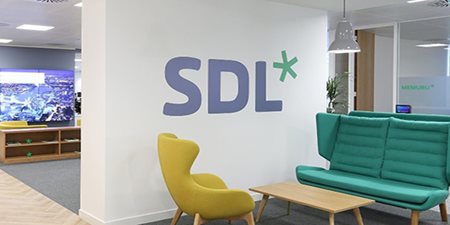SDL's Language Solutions & Neural Machine Translation
On July 23rd SDL confirmed, that it has completed the acquisition of the Donnelley Language Solutions. The $77.5 million acquisition marks the first major acquisition under the leadership of Adolfo Hernandez, CEO of SDL who was appointed in March 2016 since taking over from Mark Lancaster who founded the company in 1992.
When Hernandez took over he changed SDL’s leadership team, streamlined the business by cutting three non-core businesses and initiated an extensive strategic review of the business. Early in his tenure, Hernandez was adamant that fixing things internally first would take precedence over growth of the acquisition by specifically stating to Slator “What I am not going to do is to just botch execution and then try to cover it with Mergers and Acquisitions.”
SDL, a provider of global content management and language translation software and services, has helped companies deliver transformative business results by enabling powerful and changing digital experiences with customers around the world.
In the past SDL, has dealt with failed technology acquisitions so you would wonder why they decided to acquire Donnelley Language Solutions. In a recent interview with Slator, Hernandez stated “We didn’t need this deal,” and stressed that “this deal is a fantastic strategy accelerator. I don’t have to change strategy. This slots right in the middle of the fairway of our strategy.”
Hernandez stated in an interview with Slator, that along with DLS’s larger client portfolio, the deal helps in improving “organizational agility,” as it brings “more people on the ground, and it gives us a new sales team and new project management team.” He also mentioned that their translation management system "Multitrans" will bring some “proprietary workflows” in “regulated environments.”
Who is Donnelley Language Solutions (DLS)?
Donnelley Language Solutions was established in 2002 within R.R. Donnelley company and in 2013 DLS became a division of Donnelley Financial Solutions Inc., which provided translation, creation, and management of content services.
In 2016, Donnelley Financial Solutions Inc. and DLS broke off from R.R Donnelley, and became their own entity. DLS has approximately 400 employees and utilized freelancers and third-party agencies to provide its translation work. It has a global presence, operating in 15 countries across North America, Europe, Asia, London, New York and Hong Kong.
Similar to SDL, DLS created a one-stop translation management solution that manages, centralizes and automates your translation workflows in a highly secure environment. MultiTrans allows you to leverage your translation memory and unifies your terminology for accuracy and high-quality translations while increasing efficiency.
 Hernandez commented "The acquisition of DLS is aligned with SDL's strategy of focusing on 'premium' industries and regulated content. The combination of our businesses will strengthen SDL's market position in financial services and life sciences, which on a combined basis, account for approximately 30 percent of the language services market. Together, we will be able to develop more differentiated industry-focused solutions by leveraging DLS' specialist services expertise and SDL's technologies. In addition, DLS brings us further skills and industry presence in Asian markets.
Hernandez commented "The acquisition of DLS is aligned with SDL's strategy of focusing on 'premium' industries and regulated content. The combination of our businesses will strengthen SDL's market position in financial services and life sciences, which on a combined basis, account for approximately 30 percent of the language services market. Together, we will be able to develop more differentiated industry-focused solutions by leveraging DLS' specialist services expertise and SDL's technologies. In addition, DLS brings us further skills and industry presence in Asian markets.
Over time, DLS and SDL will seek to increase cross-selling across our customer bases and both businesses will be able to benefit from SDL's investments in Machine Translation, in-house linguists, 'Helix': our business process automation platform and administrative efficiencies, to drive margins towards our stated targets. We are delighted to welcome our new employees and customers to SDL."
How Will This Affect Clients on Both Sides?
While there are no immediate plans to change how SDL and DLS currently do business, merging and integrating the two providers will be a huge undertaking. DLS brings some big global accounts, so they will be managing multiple product portfolios (TMS, GroupShare, WorldServer, and for MultiTrans) which will keep all of their customers happy.
Hernandez did comment and said that “we are not going to be looking at changing or deploying tools like Helix [SDL’s productivity platform/initiative] to [DLS’] work initially. However, sometime [in 2018], we will work with them on deciding what is the best integration point, transition point, or migration point to bring everyone to a common operating platform.”
SDL Reaches an Industry Benchmark
In addition to the news, SDL has also announced that their SDL Neural Machine Translation (NMT) 2.0 has mastered Russian to English translation. Since the Russian language is complex with many intricacies, it is one of the toughest for machine language translation to translate. SDL’s NMT 2.0 recently proved itself and has outperformed all industry standards, with over 90% of the system’s output labeled as perfect by professional Russian-English translators.
“One of the toughest linguistic challenges facing the machine translation community has been overcome by our team,” said Adolfo Hernandez, CEO at SDL. “It was the Russian language that first inspired the science and research behind machine translation, and since then it has always been a major challenge for the community. SDL has deployed breakthrough research strategies to master these difficult languages and support the global expansion of its enterprise customers. We have pushed the boundaries and raised the performance bar even higher, and we are now paving the way for leadership in other complex languages."
”The linguistic properties and intricacies of the Russian language relative to English make it  particularly challenging for MT systems to model. Russian is a highly inflected language with different syntax, grammar, and word order compared to English. Given the complexities created by these differences between the Russian and English language, raising the translation quality has been an ongoing focus of the SDL Machine Learning R&D team."
particularly challenging for MT systems to model. Russian is a highly inflected language with different syntax, grammar, and word order compared to English. Given the complexities created by these differences between the Russian and English language, raising the translation quality has been an ongoing focus of the SDL Machine Learning R&D team."
“With over 15 years of research and innovation in machine translation, our scientists and engineers took up the challenge to bring Neural MT to the next level,” said Samad Echihabi, Head of Machine Learning R&D at SDL. “We have been evolving, optimizing and adapting our neural technology to deal with highly complex translation tasks such as Russian to English, with phenomenal results. A machine running SDL NMT 2.0 can now produce translations of Russian text virtually indistinguishable from what Russian-English bilingual humans can produce.”
Ending Notes
Only time will tell if this recent acquisition will become another fail, but I firmly believe that SDL has made the right move in acquiring DLS. They are definitely taking a step of advancement that will separate themselves from the others in this fragmented industry.
This acquisition will give SDL a major boost in its services business along with SDL perfecting the Russian to English machine translation and the combined technologies of two industry leaders. In my opinion, the other players in the translation industry will be playing catch up.

Natalie Evans
Natalie Evans has over 16-years in the tech industry and currently works as the event coordinator and tech reporter for CMS-Connected, keeping up-to-date on what's happening in and around the Content Management industry.